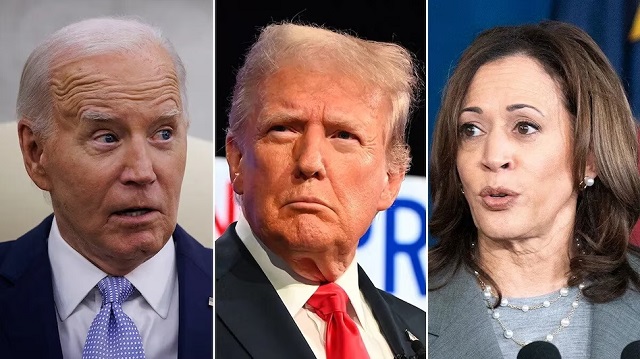
What accounts for Vice President Kamala Harris’s disappointing electoral performance, especially with working-class voters?
COMMENT | DANI RODRIK | As US president, Joe Biden charted a new economic path for the Democrats by siding unabashedly with the working class and introducing a wide range of industrial policies to reinvigorate manufacturing, reshore supply chains, and promote the green transition. Most of these new policies made economic sense, and like many other progressives, I thought they made political sense as well. What, then, accounts for Vice President Kamala Harris’s disappointing electoral performance, especially with working-class voters?
Donald Trump’s appeal, like that of right-wing ethnonationalists elsewhere, owes much to rising levels of economic insecurity, which many regard as the result of deregulation, increased corporate power, globalization, deindustrialization, and automation. As the traditional champions of the underdog, center-left parties could have benefited from these developments. But they had come to speak more for educated, professional elites, and they were slow to change course. Faced with the growing perception that they had abandoned their working-class roots, Biden’s move toward economic populism seemed like the right strategy.
One interpretation of Trump’s re-election is that economic populism was a mistake, implying that the Democratic Party should have moved more forcefully to the center instead. But Harris’s apparently fruitless efforts to woo middle-of-the-road Republican voters was not much of a success, either.
There are at least three other possibilities. The first is that Biden’s strategy did work, but not enough to win the election. Inflation and the increased cost of living have produced a generalized backlash against governments everywhere. A widely circulated chart in the Financial Times shows that incumbents have fallen short of their previous share of the vote in every election in 2024. To Bidenomics’ credit, Democrats did much better by comparison.
The second possibility is that it takes time for new policies to show effects and result in new political coalitions. Bidenomics is still new, and it faced the daunting challenge of dislodging more than three decades of voter experience with Democratic centrism. Perhaps it was too much to expect Biden’s pro-worker rhetoric and strong manufacturing construction numbers to overcome the cleavages that have emerged (and deepened) since President Bill Clinton’s administration. It takes more than a few years of well-designed policy to engineer a political realignment.
The third, and least discussed, possibility is that Bidenomics was economic populism of the wrong kind. By focusing on manufacturing, old-style union power and worker organizations, and geopolitical competition with China, it paid too little attention to the changing structure of the economy and the nature of the new working class. In an economy where only 8% of workers are employed in manufacturing, a policy that promises to restore the middle class by bringing manufacturing back home is not only unrealistic; it also rings hollows, because it does not align with workers’ aspirations and everyday experiences.
The typical US worker today is no longer rolling steel or assembling cars. Rather, he or she is a long-term care provider, a food preparer, or someone running an independent small business (perhaps through gig work). Addressing the problems of low pay and precarious working conditions in such services requires a different strategy than manufacturing incentives or import tariffs. Likewise, class solidarity needs to be built differently than through appeals to unions or bargaining power. Biden had the right idea, according to this view, but failed to hit the right targets.
Our new economic structure requires a twenty-first-century version of “industrial policy” that focuses on creating good jobs in services. Such a strategy entails organizational and technological innovations to upgrade work in low-pay activities and improve the provision of inputs such as digital tools, customized training, and credit. One can find local and national examples of such initiatives, but they remain small-scale and largely incidental to federal programs.
New technologies that help workers, rather than displace them, are critical to this effort. Green industrial policies show that innovation can indeed be redirected from carbon-intensive activities to more sustainable ones. Now we need a similar push for labor-friendly technology policies to promote innovation that enables workers with less than a college education to perform more complex tasks in care and other personal services. By developing new visions of economic specialization and mobilizing the needed resources, cross-sectoral coalitions, often led by public agencies, can foster local job creation in regions that have been scarred by long-term unemployment.
It is worth noting that in one poll taken before the election, Hispanic voters in Texas said that their biggest problem with the Democrats is that it is “the party of welfare benefits for people who don’t work.” While social transfers to the poor – those who either cannot work or face temporary unemployment – are a necessary and integral part of the contemporary welfare state, parties of the left cannot allow themselves to be defined exclusively in such terms. They need to be seen as advocates for those who want to contribute to their community through decent work, and as facilitators for those who face obstacles in doing so.
Reconnecting the Democratic Party to its roots must start with the recognition that today’s working class has changed and has different needs. The provision of social insurance and countervailing power against business interests will always remain important elements of the progressive left. But these goals must be augmented with a revamped set of “good jobs” policies that neither fetishize manufacturing nor view it through the lens of geopolitical competition with China.
*****

Dani Rodrik, Professor of International Political Economy at Harvard Kennedy School, is President of the International Economic Association and the author of `Straight Talk on Trade: Ideas for a Sane World Economy’ (Princeton University Press, 2017).
Copyright: Project Syndicate, 2024.
 The Independent Uganda: You get the Truth we Pay the Price
The Independent Uganda: You get the Truth we Pay the Price



